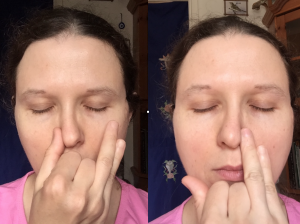Alternate nostril breathing
This exercise is used to balance the energy channels in the body and quickly calm down the mind. Regular practice helps control negative emotions, improves digestion, promotes relaxation and good sleep.
- Summary of the steps
- What is alternate nostril breathing?
- What is it good for?
- How should I do it?
- What do I do if my nose is blocked?
Summary of the steps
If you need a quick reminder, here it is. If you are just learning, please read the detailed description below.
1. Sit comfortably with the head and spine upright.
2. Exhale through the nose.
3. Close your right nostril with your right thumb and inhale through the left nostril.
4. Close your left nostril with your right ring finger and release your thumb off your right nostril.
5. Exhale through the right nostril.
6. Inhale through the right nostril.
7. Close your right nostril with the thumb, release your right ring finger off the left nostril.
8. Exhale through the left nostril.
9. Start again by breathing in though the left nostril and continue from step 4.
Start slowly with one or two rounds and gradually increase. Never force the practice. Don’t hold your breath forcefully at any step, breathe at your natural comfortable pace. Sit quietly for a few minutes after you have finished.
What is alternate nostril breathing?
Alternate nostril breathing (known in Sanskrit as Nadi Shodhana, Nadi Shuddhi, and anulom-vilom pranayama) is a simple yet powerful breathing exercise. Nadi Shodhana comes from Yoga, but you do not have to be a yogi to practise and benefit from it. It can be practised by everyone every day for short periods of time (up to 10 minutes).
Nadi Shodhana involves breathing in and out through alternate nostrils in a relaxed way for a few minutes at a time. It can be done in any seated position, at home, at work, on the train, plane or anywhere.
In Ayurvedic terms, Nadi Shodhana is one of the most effective ways of balancing Vata Dosha and is important in Vata management. In modern terms, this exercise balances the nervous, endocrine and digestive systems at the same time. It is a calming centering practice indispensable in the modern days.
What is it good for?
Regular practice of Nadi Shodhana has the following benefits:
| reduces stress and anxiety | improves sleep |
| improves mood | relieves pain |
| enhances mental performance | helps create mental peace and calmness |
| improves alertness, concentration, memory, coordination and clarity of thought | increases absorption of oxygen and your energy levels |
| increases vitality | improves efficiency of expelling carbon dioxide from the blood |
| activates the parasympathetic nervous system promoting relaxation and undoing the effects of stress | quiets down the limbic system helping control your worries and other negative emotions |
How should I do it?
This practice should be performed on an empty stomach (at least 1-1,5 hours after a meal).
Sit in a comfortable position with your head upright and your spine straight. You can sit on a chair or a sofa, or on the floor, you can use the wall or pillows for support; the most important is that you feel comfortable throughout the practice. You don’t have to close your eyes, but it can help you feel calmer more quickly.
Before you begin, relax your shoulders and prepare yourself to spend a few minutes doing this breathing practice. When you start breathing through alternate nostrils, do not force your breath. Breathe naturally, in a way that is comfortable for you.
Hold your right hand in front of your face with your palm facing towards you. Fold in your index and middle finger towards your palm:

Place your thumb above your right nostril, and your ring finger above the left nostril. You can support your right elbow with your left hand, just make sure this does not restrict the movement of the chest and abdomen. If for whatever reason you cannot use your right hand, you can use your left hand instead.
Exhale through the nose. By gently placing your thumb on the upper part of the right nose wing, block the airflow through the right nostril and inhale through the left nostril (left panel of the picture below).
Gently place your ring finger on the upper part of the left nostril and close the left nostril, immediately followed by releasing the thumb and opening the right nostril. Exhale through the right nostril (right panel of the picture below). Without changing the position of your hand inhale through the right nostril, then gently close the right nostril with your thumb and release the ring finger opening the left nostril. Exhale though the left nostril.
This completes one cycle of alternate nostril breathing or Nadi Shodhana. Repeat alternate nostril breathing for several minutes starting, for example, with two and gradually building up to a maximum of ten minutes. Alternatively, you can decide to start with one or two cycles and then slowly build up.

Left panel: inhale through the left nostril by gently closing the right nostril with the thumb. Right panel: exhale through the right nostril by releasing the thumb and gently closing the left nostril with the ring finger.
The picture above aims to clearly show what exactly is going on with the fingers and the nose. In practice, your thumb and ring finger will not be going far away from the nostrils but will hover over them. Make sure that you apply very little force on your nose wings and do not hurt your nose!
At the beginning, do not slow down or speed up your breathing. Once you get used to this practice, you can gradually deepen and lengthen your breathing, taking longer to complete each cycle. You can then start paying attention to the length of inhalation and exhalation and try to make exhalation last slightly longer than inhalation.
In any case, make sure you do not hold your breath between breathing in an out longer than it is necessary to changes the position of your thumb and ring finger. There should be no hyperventilation, no shortness of breath or any uncomfortable symptoms. Try to make inhalation and exhalation as quiet as possible; ideally a person sitting next to you should not hear it.
The best is to do this exercise twice a day: in the morning after waking up and in the evening before going to bed. You will notice the effect very soon, but to get a long-lasting effect it will take at least eight weeks of regular practice.
What do I do if my nose is blocked?
If you have a cold, then wait until you feel well again and then start practising alternate nostril breathing.
If you have a mild chronic congestion, try practising very gently. Mild congestion usually responds well to Nadi Shodhana if practised with sensitivity. Apply small amounts (2-3 drops per nostril) of pure cold pressed sesame oil or ghee (clarified butter) right before doing Nadi Shodhana. The oil helps remove mucus and soothes irritated mucus membranes.
If you are practising yogic nasal cleansing (Jala Neti), make sure you always apply oil afterwards to keep Vata Dosha in balance.
If there is a stubborn nasal congestion, it may require a separate treatment and Nadi Shodhana in this form might not be possible. There is an option to do this process in your imagination, visualising the air entering though your left nostril and exiting from the right nostril etc, but this is a topic for a separate post.
Based on my own experience and explanations by Vaidya Atreya Smith, Dr Sharad Bhalekar of Kaivalyadhama Ashram and Yoga Research Institute and other teachers.
P.S. The following video contains a demonstration starting from 01:15. There might be slight discrepancies between the instructions in this video and the text above, but they are nonessential. Just try to do this practice regularly and you will notice the results. The best practice is the one you do!